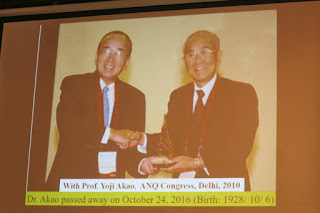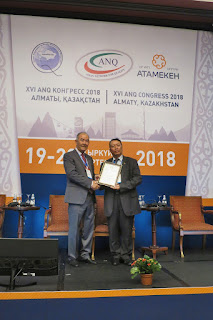Asian Network for Quality (ANQ) Congress
2018 was held in InterContinental
Hotel, Almaty, Kazakhstan was held from 19-20 Sep 2018. The
congress theme was “The Future of Quality Leadership in IT-Age”. The second day of ANQ
Congress 2018 was held on 20 Sep 2018. Morning session was parallel sessions. HKSQ team took a photo in front of the
Congress banner.
Parallel Session III
I
attended the session C2 (Technology and Models for Business Excellence) late. Mr. Too was the session chair. At that time the speaker was Mr. D.M. Liao
(REDI, Taiwan) and his presentation entitled “The Promotion of Reliability
Management and Engineering Practices Model – Machine Tool Industry as
Example”. He said the reliability
enhancement tools proposed by Reliability Engineering Development Institute
(REDI) since June 2016.
Mr. Liao
introduced REDI-PRM® (REDI-Reliability Practice Model) with other
tools including FMEA, CADM, QC 7 tools and FRACAS, etc. REDI-PRM®
was the most effective, efficient, and fundamental methods to achieve both the
quality and reliability goals.
And then
I went to the session C3 (Service Excellence and Customer Satisfaction). Ms. Elizabeth M. Keim (Managing Partner,
Integrated Quality Resources; President, IAQ) was last speaker of the session
and her topic entitled “Using Lean Six Sigma to Improve Customer Experience”. She aimed participants would become familiar
with methods for determining customers’ experience and understand how results
of customers’ experience could be improved using LSS.
Ms. Elizabeth Keim briefed the different among Customer Experience, Customer Satisfaction/Dissatisfaction and Customer Loyalty. For measuring customer loyalty, she suggested to use Net Promoter Score (NPS).
Then she
briefed the sources of customer-oriented data included Usability testing,
Surveys, Focus groups, Heuristic evaluations, Competitive analyses, Complaint
tracking, Referral tracking and Social media monitoring. And the she discussed Kano Theory of
Attractive Quality. Lastly, she shared
the practical implications of the research on the efficacy of self-assessment
that organizational maturity impacts the value of framework-based
evaluations.
Prof.
Wan Seon Shin (President of KSPE, Former President of KSQM and Professor,
Sungkyunkwan University) was the session chair and presented appreciation
certificate to Ms. Elizabeth
Keim.
During
the break, I took a photo with Mr. Too Meng Ken (SQI).
After that Minda and I attended different session and the summary as follows.
In session D2 (Technology and Models for Business Excellence), the first speaker was Dr. SANO Masataka (Asso. Professor, Chiba Institute of Technology) and his topic was “Process-Oriented Analysis Method (POAM) for Clinical Laboratory Testing”.
In the beginning, Dr. Sano introduced process oriented thinking that medical incidents to improve the work method to prevent errors either from human factors (carelessness) or process factors. The Medication Model separated Information, Objects and Jobs.
He
showed the viewpoints list which focused on process factors using medication
model.
After
analyzed 232 cases from 2015 to 2017, he modified the model as follows. Dr.
Sano concluded that POAM enabled to visualize incidents in the process of
clinical examination and identified error factors from incident reports. The
future tasks were to identify the related error and accident factors and
provide countermeasures.
Prof.
Cher Ming Tan (Center for Reliability Sciences & Technologies, Chang Gung
University, TW; SQI) was speaker in session C2 and his topic named “Implementation
of Predictive Maintenance Strategy on Haemodialysis Machines”.
He said
Reliability based maintenance scheme could help to evaluate regular maintenance
period in such a way that the maintenance frequency was lesser than the
existing policy, while keeping the reliability in acceptable limits. Based on the Cost Model, it would decrease
the net cost of maintenance.
Lastly,
Prof. Cher mentioned the improvement upto 18.18% regular maintenance cost
reduction and saving 18,279 NTD per year per machine without early failure.
The last
parallel session I attended was in session D1 (Improvement of Public Service
Quality) and Mr. Chae-Hoon Lee (Associate Researcher, Service Innovation
Centre, KSA) was the speaker with the topic entitled “Analysis on Service
Quality Level and Performance of KS-SQI Model: Based on Korean Tourism Service
Industry”.
Mr. Lee
introduced KS-SQI model which was developed by Korean Standards Association
(KSA) to measure the service quality, and had been measuring service quality
index of the service industry in Korea for the past 18 years since 2000. In 2018, they conducted KS-SQI for 72
categories and 7 public services included 316 companies & organizations.
KS-SQI has 7 different dimensions based on the assessments given by the dcustomers who had first-hand experience with the service.
After
reviewed different assessment results in tourism service industry, Mr. Lee
concluded that KS-SQI model application could bring precise analysis on the
quality level of Korean service industry and ultimately to deliver positive
contribution to improving global competitiveness of service companies based on
the outcome of the analysis.
Completed
the parallel session, I took a photo with Mr. Chae-Hoon Lee.
And then
we had a cooperation meeting before lunch.
Mr. Lee invited HKSQ to promote KS-SQI and this model had promoted and
implemented in Singapore through SQI. We
discussed different business models to explore the possibility for implementing
in Hong Kong. Preliminary thought would
be linked up with HKQAA and CityU.
After
lunch, it was Plenary Session III. Minda
took a photo with Prof. Phulporn Sangbangpla (SQAT) at that time.
The
first keynote speaker was Mr. Changkun Yan (YOFC Deputy CEO; GM of Manufacturing
Center, Yangtze Optical Fibre and Cable Joint Stock Co., Ltd.) and his topic
entitled “YOFC Intelligent Manufacturing”.
Firstly, Mr. Yan briefed the company history which was Sino-foreign
joint ventures in China established in 1988 and officially operation in
1992.
Then Mr.
Yan introduced YOFC iMES System in which employed two key Intelligent
Manufacturing Technologies below:
i)
Digitized Manufacturing Technology – Create a model for manufacturing
and enable simulation, covering product design, numerical control technology,
product management, business collaboration, etc., that is the foundation of
digital manufacturing.
ii)
Sensor Technology – The more sensors that are used in enterprises, the
more information will be obtained.
And then
Mr. Yan said their YOFC Production Command Centre could grasp real-time
information with regard to production, equipment, technology and operation,
thereby achieving transparent management for the smart factory. He showed their online and intelligent quality
control to us.
Lastly,
Mr. Yan showed the virtual factory design which included four key elements that
were Simulation, Transparent Factory, Monitoring and Analysis, as well as,
Virtual Training. He also shared the
effects of iMES implementation such as inventory reduced by more than 10%,
prevent errors by more than 95%, Warehouse staff reduction by 50% and Order
implementation transparency improvement upto 50%.
Mr.
Janardan Ghimire (President, NQPCN) was the second keynote speaker and his
presentation named “Integrated Management System (IMS) Transforming
Institutional Excellence through Hands-on Approach”.
In the
beginning, Mr. Janardan Ghimire briefed the journey of quality in global
prospective from 1906 to beyond 2000.
And then
he introduced IMS based on ISO 9001, ISO 14001 and ISO 45001. The House of Quality of IMS model was
developed. He also added five pillars needed to be managed properly to be able
to achieve an excellence. Five pillars
are “Change”, “Resources”, “IT & Knowledge”, “Process” and “Audit”.
Finally,
Mr. Janardan Ghimire proposed Institutional / Organzation Excellence model with
different quality concepts and tools which was his hands-on experience.
Prof.
Noriaki KANO (Professor Emeritus, Tokyo University of Science; Honorary
Chairperson, ANQ) was the third keynote speaker and his topic entitled “Impact
of ICT on Application of Quality Tools”.
Firstly, Prof. Kano revisited quality tools that were developed but not
popular in the 20th Century such as Quality Table and T-typed
Matrix.
Quality
Table come from Quality Function Deployment that Prof. Kano was the moderator
of the session where the first presentation was made at the JUSE QC Conference
held in Fukuoka, Kyushu, in 1972 that he found a new tools for R&D. Prof. Yoji Akao was father of QFD and got Ishikawa-Kano
Award in ANQ Congress 2010. Mizuno’s +
Akao’s Discovery was the revolutionary process from “Product out” to “Market in”.
The
disadvantage of Quality Table at that time was paper space problem. Prof. Kano said we needed tatami-length paper
to list up all the customer requirements for one product. ICT (e.g. application of Excel) would release
people from the constraint of paper size such as A4 or A3. (Remark: My interpretation is that ICT releases
working style from 2 dimension to multi-dimension.)
And then
Prof. Kano briefed the QA Matrix which was form Building Quality into the
Process (BQiP). He raised example of JKK
in Toyota that potential process might be far from inspection. Another tool named T-typed Matrix was
introduced which reduced troubles in New Product Development.
Lastly,
Prof. Kano concluded the drastic advancement of ICT that was able to help
quality tools applied more easily, speedily, effectively and efficiently.
Mr.
Kitson Leonard (Vice-chairman, SQI) was the last keynote speaker and his
presentation was “Building a Culture of Service”. First, he discussed Culture that defined who
you are and what you stand for. He used
Apple as example. Apple’s motto “Think
different” was success culture of service to distinct with other
competitors.
Then he said technology use in enhancing the customer experience. He used “SG Secure” as example that was Apps for citizen who spotted any potential criminal issues and then took a photo uploading through the Apps (Image & location obtained). SG police would took action immediately. It made Singapore to be safe country.
At the
end, Mr. Kitson Leonard introduced the open of Inaugural (ANQ) Asian Service
Award and the application would start in January 2019.
Discussion
panel
During
the break, I took a photo in the first row professionals.
Plenary Session IV
Awarding
of the winners of Asian Excellence in Quality Practice ARE-QP and there were
nine awardees below:
i)
Haier Group
ii)
Moscow Power Engineering Institute
iii)
Jiaxipera Compressor Co., Ltd.
iv)
General Medical Practice Center
v)
AZMK LLP
vi)
PTT Global Chemical Plc.
vii)
Toyota Motor Thailand Co., Ltd. (Samrong Plant)
viii)
Buffalo Machinery Co., Ltd.
ix)
Hungkuang UniversityDr. Larisa Fedyk (Head of the Central Organ the System, Federal Acency on Technical Regulating and Metrology System of Voluntary Certification) represented Moscow Power to receive the award from Prof. Azat.
And then
Prof. Azat presented Best Paper Award to speakers.
Prof.
Cher Ming Tan (SQI)
Dr.
Lotto Lai (HKSQ)
My paper
title was “Quality Innovation Using an Extenics Six Sigma (ExSS) Approach and a
Case Study”. It is a good new for me to
promote Extenics continuously.
Dr. Ngo
Van Nhon (VQAH)
Prof.
Thanakom Soontarnchainacksaeng (SQAT)
Mr. Too
Meng Ken (SQI)
Speakers awarded from Korea.
Speaker awarded from Japan.
All
awardees took a group photo.
I was
honor to stand with Prof. Ching-Chow Yang (楊錦洲) (CSQ) who received the first
Ishikawa-Kano medal.
Lastly, Prof.
Thanakom Soontarnchainacksaeng (President, SQAT) introduced the ANQ Congress
2019 would be held in Thailand from 21-24 Oct 2019. The Congress Venue was in Chulalongkorn
University.
Introductory
video for coming ANQ was showed.
Before
Prof. Azat gave closing speech, he invited all KOQIM staff to took a group
photo.
At the end, Prof. Azat gave closing speech and looking forward to see us in ANQ Congress 2019.
Before
the ANQ Gala Dinner, I took some photos for memory.
(Left: Prof. Thanakom Soontarnchainacksaeng (SQAT), I and
Dr. Panisuan Jamnarnwej (SQAT))
I met Dr. Takeshi Kaneko
from Japan and we met in ANQ Congress every year.
Dr. Zoie
Wong (HKSQ) and Ms. Haruka Yamashita took a photo for memory.
We
appreciated Mr. Dias assisting in congress arrangement and hospitality.
Finally,
Mr. Too, Minda and I were invited by KOQIM congress helpers to take a group
photo.
Reference:
Asian Network for Quality (ANQ) - http://www.anforq.org/
20180917:
Pre-ANQ Congress 2018 – WACQ Meeting in Kazakhstan - https://qualityalchemist.blogspot.com/2018/09/pre-anq-congress-2018-wacq-meeting-in.html
20180918:
Pre-ANQ Congress 2017 City Tour in Almaty, Kazakhstan - https://qualityalchemist.blogspot.com/2018/09/pre-anq-congress-2017-city-tour-in.html
20180919:
ANQ Congress 2018 Almaty, Kazakhstan – Day 1 (Part A) - https://qualityalchemist.blogspot.com/2018/09/anq-congress-2018-almaty-kazakhstan-day.html
20180919:
ANQ Congress 2018 Almaty, Kazakhstan – Day 1 (Part B) - https://qualityalchemist.blogspot.com/2018/09/anq-congress-2018-almaty-kazakhstan-day_19.html



























































沒有留言:
發佈留言